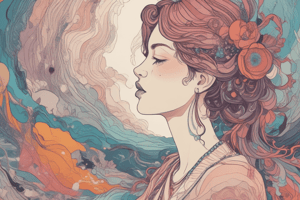Podcast
Questions and Answers
Which action is most crucial in conceptual art, distinguishing it from traditional art forms?
Which action is most crucial in conceptual art, distinguishing it from traditional art forms?
- The size and dimensions of the artwork.
- The material used to construct the artwork.
- The idea or concept behind the artwork. (correct)
- The physical skill in creating the art piece.
The 'art world' exclusively refers to commercial galleries and auction houses.
The 'art world' exclusively refers to commercial galleries and auction houses.
False (B)
Name three different types of dry media used in creating 2-dimensional art.
Name three different types of dry media used in creating 2-dimensional art.
pencil, charcoal, colored pencils
In art, the term ______ refers to the specific material and technique used to create a work.
In art, the term ______ refers to the specific material and technique used to create a work.
Match the following art dimensions with their representative forms:
Match the following art dimensions with their representative forms:
What is a key characteristic that distinguishes wet media from dry media in art?
What is a key characteristic that distinguishes wet media from dry media in art?
Conceptual Art places more importance on the visual appeal of the final product than the underlying concept or idea.
Conceptual Art places more importance on the visual appeal of the final product than the underlying concept or idea.
Briefly explain how the definition of the 'art world' has evolved to include more than just commercial aspects.
Briefly explain how the definition of the 'art world' has evolved to include more than just commercial aspects.
Which of the following best describes the etymological origin of the word 'art'?
Which of the following best describes the etymological origin of the word 'art'?
According to the provided definitions, an object must evoke a positive emotional response to be considered a work of art.
According to the provided definitions, an object must evoke a positive emotional response to be considered a work of art.
Explain how personal factors such as values and history can influence one's perception and definition of art.
Explain how personal factors such as values and history can influence one's perception and definition of art.
The Greek word _______ refers to technique and deliberate action and is related to the origin of the word art.
The Greek word _______ refers to technique and deliberate action and is related to the origin of the word art.
What is a central theme when considering the evolution and understanding of 'contemporary art'?
What is a central theme when considering the evolution and understanding of 'contemporary art'?
The artistic paper-only activity requires that you use specifically colored paper.
The artistic paper-only activity requires that you use specifically colored paper.
According to F. Wellington Ruckstuhl, what is the criteria that denotes great art?
According to F. Wellington Ruckstuhl, what is the criteria that denotes great art?
Match the following terms with their best description connected to the study of art:
Match the following terms with their best description connected to the study of art:
Flashcards
Conceptual Art / Conceptualism
Conceptual Art / Conceptualism
An art movement where the idea behind the artwork is more important than the physical object itself.
Art World
Art World
The network of individuals and institutions involved in the production, display, critique, and sale of art, primarily modern and contemporary art.
3D (3-Dimensional) Art
3D (3-Dimensional) Art
Art that has height, width, and depth. Examples include sculptures and architecture.
2D (2-Dimensional) Art
2D (2-Dimensional) Art
Signup and view all the flashcards
Medium / Media
Medium / Media
Signup and view all the flashcards
3D (3-Dimensional): Sculpture / Architecture
3D (3-Dimensional): Sculpture / Architecture
Signup and view all the flashcards
2D (2-Dimensional) - Dry vs. Wet Media
2D (2-Dimensional) - Dry vs. Wet Media
Signup and view all the flashcards
3D Medium Examples
3D Medium Examples
Signup and view all the flashcards
What is "ART"?
What is "ART"?
Signup and view all the flashcards
Working Definition of Art
Working Definition of Art
Signup and view all the flashcards
Art as Emotional Expression
Art as Emotional Expression
Signup and view all the flashcards
Subjectivity of Art
Subjectivity of Art
Signup and view all the flashcards
What is Aesthetics?
What is Aesthetics?
Signup and view all the flashcards
What is 'innovative'?
What is 'innovative'?
Signup and view all the flashcards
What is Contemporary Art?
What is Contemporary Art?
Signup and view all the flashcards
Art World (Framework of Art)
Art World (Framework of Art)
Signup and view all the flashcards
Study Notes
- Study notes for Module 1: Introduction to Art
Reflection Questions
- What are you willing to contribute to ensure a meaningful art class?
- What are your strengths and areas for improvement as an art student?
- How will you use what you learn in this art class in your life?
Module Objectives
- Define art, contemporary art, and aesthetics.
- Understand the art world framework.
- Classify the different kinds of visual arts
- Describe the medium in art
Defining Art
- What constitutes art?
- What are your experiences of art?
- How do your concepts compare to those in a given video?
- Do you agree/disagree with key points in the video?
Etymology of "Art"
- The Latin word "ARTEM" (nominative "ARS") translates to skill/craft that requires training.
- The word is also related to the Greek word "TECHNE," which means technique, deliberate, conscious, intended action.
Working Definitions of Art
- Art refers to physical objects or things intentionally made to be experienced visually and spatially.
- Every human work, in any language, with the purpose of expressing or stirring human emotions is a work of art.
- A work of art's greatness correlates to its power stirring highest emotions in the largest number of cultured people for the longest time.
- Art varies from person to person based on factors such as values, story, and history, making it tough to single out one definition.
Contemporary Art
- What makes something innovative?
- What innovations have been seen in art across history?
Aesthetics
- What is Aesthetics
- What constitutes "good art"?
- Who determines what "good art" is?
Art Activity: Paper-Only Creation
- The goal is to create an art piece using only paper.
- Think of an idea that you can translate into paper.
- Prepare paper material; note that you are not allowed to incorporate other mediums i.e. paint, pencil and crayons
- Manipulate the paper to represent the idea/concept.
- Take a photo of the art piece
- On Google Slides, attach the photo of the art piece and explain the idea/concept behind the work; include the title.
- Conceptual art is a historical movement from the 1960s and 1970s where the idea functions as the work itself.
- It shifts art's value and quality from physical objects to the immaterial concept.
- Consider how paying attention to details in your work can be either advantageous or detrimental.
Understanding the Art World
- The art world is an umbrella term for professional actors and entities in the field of art focused on modern and contemporary art.
- Different spheres exist commercially and critically, forming a complex web of interactions, transactions, and collaborations.
- The art world refers to visual artists, dealers, critics, collectors, and institutions like galleries, museums, auction houses, and art fairs.
Classifying Art: Dimensionality
- 3D (Three-Dimensional): Sculptures (freestanding, relief) and architecture.
- 2D (Two-Dimensional): Art on a flat surface, e.g., painting, drawing, illustrations, or photographs.
Elements Needed to Create Art
- Medium: the particular material, along with its accompanying technique.
- 3D Media for Sculpture/Architecture: stone, wood, clay, metal, glass, fiber, plastic, etc.
- 2D Media
- Dry Media: pencil, charcoal, colored pencils.
- Wet Media (Paint): water-based (dries by evaporation), oil-based (dries by polymerization).
- Others: photography, mosaic, print-making.
Elements of art
- Dot, Point, Line, Shape, Texture, Color, Space, Volume, Light/Value.
- These are the basic components used by artists when producing works of art.
Principles of Design
- Balance, Rhythm, Scale and Proportion, Contrast, Emphasis, Variety, Unity, Repetition.
- Reflect how elements of art are used.
Studying That Suits You
Use AI to generate personalized quizzes and flashcards to suit your learning preferences.




